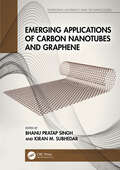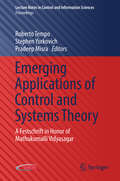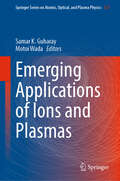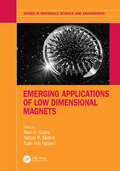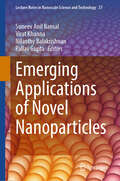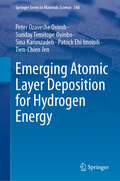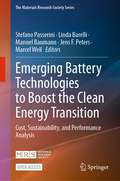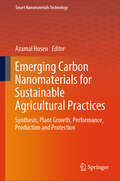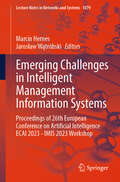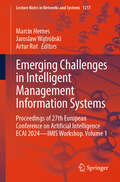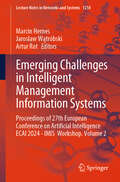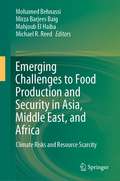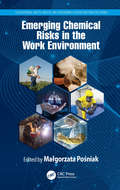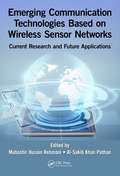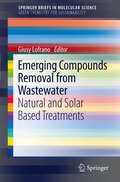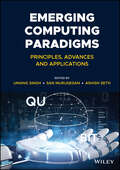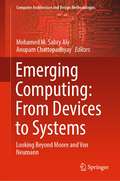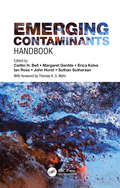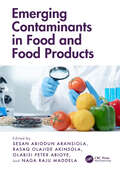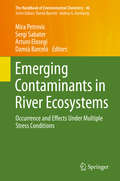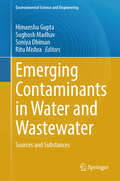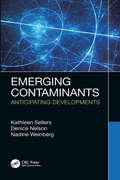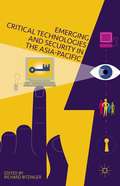- Table View
- List View
Emerging Applications of Carbon Nanotubes and Graphene (Emerging Materials and Technologies)
by Bhanu Pratap Singh Kiran M SubhedarThis book comprehensively reviews recent and emerging applications of carbon nanotubes and graphene materials in a wide range of sectors. Detailed applications include structural materials, ballistic materials, energy storage and conversion, batteries, supercapacitors, smart sensors, environmental protection, nanoelectronics, optoelectronic and photovoltaics, thermoelectric, and conducting wires. It further covers human and structural health monitoring, and thermal management applications. Key selling features: Exclusively takes an application-oriented approach to cover emerging areas in carbon nanotubes and graphene Covers fundamental and applied knowledge related to carbon nanomaterials Includes advanced applications like human and structural health monitoring, smart sensors, ballistic protection and so forth Discusses novel applications such as thermoelectrics along with environmental protection related application Explores aspects of energy storage, generation and conversion including batteries, supercapacitors, and photovoltaics This book is aimed at graduate students and researchers in electrical, nanomaterials, chemistry, and other related areas.
Emerging Applications of Control and Systems Theory: A Festschrift In Honor Of Mathukumalli Vidyasagar (Lecture Notes In Control And Information Sciences - Proceedings Ser.)
by Roberto Tempo Stephen Yurkovich Pradeep MisraThis book celebrates Professor Mathukumalli Vidyasagar’s outstanding achievements in systems, control, robotics, statistical learning, computational biology, and allied areas. The contributions in the book summarize the content of invited lectures given at the workshop “Emerging Applications of Control and Systems Theory” (EACST17) held at the University of Texas at Dallas in late September 2017 in honor of Professor Vidyasagar’s seventieth birthday. These contributions are the work of twenty-eight distinguished speakers from eight countries and are related to Professor Vidyasagar’s areas of research. This Festschrift volume will remain as a permanent scientific record of this event.
Emerging Applications of Ions and Plasmas (Springer Series on Atomic, Optical, and Plasma Physics #127)
by Samar K. Guharay Motoi WadaThis book discusses recent advances in the science and technology of charged particles and emerging frontiers in applications of ions and plasmas. In particular, this includes: ion/plasma interactions with soft matters, especially, interrogating local bio cells, bio systems, liquids and gels; interactions with ambient environments; processes associated with fine-scale characterization of materials, materials modification, new material discovery, and above all, plasma chemistry. The book takes a broad view of the underlying problems with a distinct aim to engage young researchers and even advanced undergraduate and beginning graduate students. The first few chapters discuss relevant broad science issues covering ions and plasmas as well as methodologies for their manipulations; in addition, mathematical and computational tools for analysis are highlighted through simple examples. This background knowledge, in turn, develops a solid foundation for the chapters on numerous emerging application areas. A balance between science and engineering, along with relevant computational modeling, simulation, and exploitation of data, is maintained throughout. Prospective outlooks for the future are discussed. Overall, this book offers a lens for the reader to get acquainted with active and fruitful emerging application domains for future explorations.
Emerging Applications of Low Dimensional Magnets (Series in Materials Science and Engineering)
by Sanjay Mishra Ram K. Gupta Tuan Anh NguyenLow-dimensional magnetic materials find their wide applications in many areas, including spintronics, memory devices, catalysis, biomedical, sensors, electromagnetic shielding, aerospace, and energy. This book provides a comprehensive discussion on magnetic nanomaterials for emerging applications. Fundamentals along with applications of low-dimensional magnetic materials in spintronics, catalysis, memory, biomedicals, toxic waste removal, aerospace, telecommunications, batteries, supercapacitors, flexible electronics, and many more are covered in detail to provide a full spectrum of their advanced applications. This book offers fresh aspects of nanomagnetic materials and innovative directions to scientists, researchers, and students. It will be of particular interest to materials scientists, engineers, physicists, chemists, and researchers in electronic and spintronic industries, and is suitable as a textbook for undergraduate and graduate studies.
Emerging Applications of Novel Nanoparticles (Lecture Notes in Nanoscale Science and Technology #37)
by Pallav Gupta Suneev Anil Bansal Virat Khanna Nilanthy BalakrishnanThis book is a comprehensive and modern guide on emerging nanoparticles and their diverse applications in engineering, medicine, food safety, transportation, energy, agriculture, and environmental sustainability. Written by leading researchers from all over the world, it is designed to cover the full range of nanoparticles as well as provide in-depth detail regarding their development, characterization, processing, and synthesis. The book is divided into two sections: the first covers the development of advanced nanoparticles and the second is dedicated to their variety of cutting-edge applications. The authors also cover the unique properties and green synthesis of nanoparticles as well as their use as nanobiosensors, nanopesticide, nanofertilizer, and as energy storage and conversion devices, just to name a few. This book provides readers with insight onto the broad scope of computational, theoretical, and experimental research on novel nanoparticles and their applications. It is ideal for both young and experienced researchers and industry professionals in the field of nanotechnology.
Emerging Atomic Layer Deposition for Hydrogen Energy (Springer Series in Materials Science #348)
by Tien-Chien Jen Sina Karimzadeh Peter Ozaveshe Oviroh Sunday Temitope Oyinbo Patrick Ehi ImoisiliThis book focuses on Atomic Layer Deposition (ALD) and its applications in the field of green hydrogen energy. It covers the fundamental understanding of how new functional materials can be synthesized by ALD, and provides insights into its use in advanced nanopatterning for microelectronics, energy storage systems, desalination, catalysis, and medical fields. The book also highlights the advancements in computational and experimental methodologies for optimizing ALD processes in the context of green hydrogen energy. The book addresses aspects that might affect deposition and green hydrogen energy, and presents analysis and characterization techniques in the field. With specific examples illustrating the progress in green hydrogen ALD processes and their impact on other technologies, this book aims to enable the reduction of cost, energy waste, and adverse environmental impacts associated with hydrogen energy. It provides a comprehensive overview of ALD technology, hydrogen production, purification, and storage methods, modeling and simulation techniques, analysis and characterization approaches, and future perspectives on green hydrogen energy.
Emerging Battery Technologies to Boost the Clean Energy Transition: Cost, Sustainability, and Performance Analysis (The Materials Research Society Series)
by Linda Barelli Stefano Passerini Manuel Baumann Jens F. Peters Marcel WeilThis open access book provides a totally new perspective on the rapidly developing sector of electrochemical energy storage, putting a spotlight on their sustainability under consideration of the latest developments and emerging future technologies. A number of selected, high-level authors from different disciplines discuss the potential contribution of batteries to a cleaner society, the need for new battery concepts, necessary new chemistries and their sustainability. These include not only analyses of the most relevant technological developments in the field, but also the latest state of knowledge in terms of their applicative functionalities in transport and stationary applications within the clean energy transition framework, their potential environmental impacts, resource demands and social impacts, and the corresponding methodological advances. All these aspects are analyzed on micro-level (i.e., for the specific technology), but also on macro-scale i.e., from a systemic perspective, providing a glimpse on how emerging battery systems might cover future energy storage demand. By taking a prospective and interdisciplinary viewpoint, this book will be of interest for a broad field of readers interested in electrochemistry, engineering with particular focus on electric grids and on-board systems and energy system analysis, but also those worried about the sustainability and societal challenges related with the energy transition(s).
Emerging Carbon Nanomaterials for Sustainable Agricultural Practices: Synthesis, Plant Growth, Performance, Production and Protection (Smart Nanomaterials Technology)
by Azamal HusenThe potential use of carbon-based nanomaterials in overall plant systems has not yet received much research, and the results that have been reported are typically descriptive and inconsistent with little knowledge of the underlying mechanisms of action. Changes in gene expression and enhanced ROS production are among the physiological processes that may be impacted by interactions with carbon nanomaterials. They penetrate plant cells, are readily taken up by plants, and then influence the key events of plants such as seed germination, seedling growth, root formation, photosynthesis, flowering, yield, and overall performance. Moreover, in terms of soil quality, carbon nanomaterials have the capacity to influence the health status of agricultural soils, and thus, increase sustainable agriculture practices. Currently, plant disease management depends mainly on toxic pesticides that are potentially harmful to humans and the environment. These particles have enabled their use as bactericides, fungicides, and nanofertilizers. Carbon nanomaterials, however, which may be helpful in plant nucleic acid delivery, pesticide and fertilizer application, wastewater treatment, eradication of pathogen-induced plant illnesses, and detection of significant plant molecules, are the subject of this book. The use of carbon nanoparticles in tissue culture medium and plant growth performance has also been examined. The so-called ‘safe-by-design’ strategy for a guided design of nanomaterials without harmful environmental side effects requires knowledge of the special structural properties of particles that determine the deleterious impacts on living beings. Accordingly, the environmental safety, and ethical issues related to the use of carbon nanomaterials in agricultural sectors have been also explored. Overall, the book in hand provides an extensive, important, and selected topic related to carbon nanomaterials in agricultural sectors. This book provides valuable information to scientists, researchers, and students, working especially on agricultural science, plant science, plant pathology, plant biology, plant nanobiotechnology, plant biochemistry, soil microbiology, and other allied subjects.
Emerging Challenges in Intelligent Management Information Systems: Proceedings of 26th European Conference on Artificial Intelligence ECAI 2023 - IMIS 2023 Workshop (Lecture Notes in Networks and Systems #1079)
by Marcin Hernes Jarosław WątróbskiThis book contains the proceedings of the ECAI 2023 Workshop on Intelligent Management Information Systems (IMIS 2023). IMIS 2023 was part of the 26th European Conference on Artificial Intelligence ECAI 2023, held in Krakow from September 30, 2023, to October 4, 2023. The book discusses emerging challenges related to implementing artificial intelligence in Management Information Systems. The main focus is put on machine learning, including deep learning to support business processes, artificial intelligence for financial systems and cryptocurrencies, intelligent human–computer interfaces, knowledge management in business organizations, hybrid artificial intelligence, and multiple criteria decision analysis methods. The book is divided into four major parts covering the main issues related to the topic. The first part presents issues related to application of artificial intelligence in information systems. The second part is devoted to advanced machine learning methods to support business processes. The third part presents problems related to the social aspects of artificial intelligence in management. The fourth part is devoted to intelligent multiple criteria decision analysis methods. The book holds an interdisciplinary character; therefore, it is intended for a broad scope of readers, including researchers, students, managers, and employees of business organizations, software developers, IT, and management specialists.
Emerging Challenges in Intelligent Management Information Systems: Proceedings of 27th European Conference on Artificial Intelligence ECAI 2024 - IMIS Workshop. Volume 1 (Lecture Notes in Networks and Systems #1217)
by Marcin Hernes Artur Rot Jaroslaw WątróbskiThis book contains the first volume of proceedings of the ECAI 2024 Workshop on Intelligent Management Information Systems (IMIS 2024). IMIS 2024 was part of the 27th European Conference on Artificial Intelligence ECAI 2024, held in Santiago de Compostela from October 19, 2024, to October 24, 2024. The book discusses emerging challenges related to implementing artificial intelligence in management information systems. The main focus is put on machine learning, including deep learning to support business processes, artificial intelligence for financial systems and cryptocurrencies, hybrid artificial intelligence, and multiple criteria decision analysis methods. The book is divided into three major parts covering the main issues related to the topic. The first part presents issues related to application of artificial intelligence in information systems. The second part is devoted to advanced machine learning and data processing methods to support business processes. The third part is devoted to intelligent multiple-criteria decision analysis methods. The book has an interdisciplinary character; therefore, it is intended for a broad scope of readers, including researchers, students, managers, and employees of business organizations, software developers, IT, and management specialists.
Emerging Challenges in Intelligent Management Information Systems: Proceedings of 27th European Conference on Artificial Intelligence ECAI 2024 - IMIS Workshop. Volume 2 (Lecture Notes in Networks and Systems #1218)
by Marcin Hernes Artur Rot Jaroslaw WątróbskiThis book contains the second volume of proceedings of the ECAI 2024 Workshop on Intelligent Management Information Systems (IMIS 2024). IMIS 2024 was part of the 27th European Conference on Artificial Intelligence ECAI 2024, held in Santiago de Compostela from October 19, 2024, to October 24, 2024. The book discusses emerging challenges related to implementing artificial intelligence in management information systems. The main focus is put on knowledge management and machine learning methods in information systems, artificial intelligence for decision support systems, intelligent customer management methods, hybrid artificial intelligence, and multiple criteria decision analysis methods and advanced computational methods for support business processes and decision-making. The book is divided into three major parts covering the main issues related to the topic. The first part presents issues related to the knowledge management in intelligent information systems. The second part is devoted to application of machine learning in management information systems. The third part presents problems related to multiple criteria decision analysis and computational methods. The book has an interdisciplinary character; therefore, it is intended for a broad scope of readers, including researchers, students, managers, and employees of business organizations, software developers, IT, and management specialists.
Emerging Challenges to Food Production and Security in Asia, Middle East, and Africa: Climate Risks and Resource Scarcity
by Mohamed Behnassi Mahjoub El Haiba Mirza Barjees Baig Michael R. ReedThis book, as a part of a series of CERES publications, provides a multi-regional and cross-sectoral analysis of food and water security, especially in the era of climate risks, biodiversity loss, pressure on scarce resources, especially land and water, increasing global population, and changing dietary preferences. It includes both conceptual research and empirically-based studies, which provides context-specific analyses and recommendations based on a variety of case studies from Africa, Middle East, and Asia regarding the fostering of long-term resilience of food and water security. The core approach of the volume consists of: assessing the structural drivers affecting the vulnerability of food and water security, under the persistence of current trends; identifying the best solutions and practices to enhance the climate resilience for food and water security; and fostering climate adaptation and biodiversity protection for food and water security.
Emerging Chemical Risks in the Work Environment (Occupational Safety, Health, and Ergonomics)
by Małgorzata PośniakAround the world, the production and use of nanomaterials, as well as carcinogenic, mutagenic, reprotoxic substances (CMR) and endocrine disruptors has systematically increased. The increase in production has exposed workers to hazardous substances in practically all branches of the world economy. Readers will have access to up-to-date and comprehensive knowledge on emerging risks related to nanomaterials, endocrine disruptors, reprotoxic, carcinogenic and mutagenic substances, which are related to the development of technologies and workplaces. The book will provide the tools for occupational risk assessment of chemical substances for which there are no safety levels of exposure as well as an indication of methods and measurements to protect human health and reduce chemical risks at the workplace. This book creates awareness for employers, employees and safety experts about emerging risks related to chemical agents resulting in the reduction of cancer, reproductive system diseases, cases of abnormal child development, hormonal system disorders leading to abnormal metabolism, obesity, and diabetes. Features: Comprehensive information on emerging and newly identified chemical hazards Delivers the latest data on methods and tools for identification, assessing and reducing health risks Provides practical occupational safety advice and recommendations Real life examples from measurements carried out in the workplaces "The monograph, due to the high universality of its considerations, can be addressed to a very wide audience. It is an important compendium of knowledge, which can be used by health and safety services, employers, people designing new technologies and those interested in this issue. It is a valuable and up-to-date study, among others because it uses the latest literature and quotes current legal acts.” —Sławomir Czerczak, Nofer Institute of Occupational Medicine, Poland
Emerging Communication Technologies Based on Wireless Sensor Networks: Current Research and Future Applications
by Al-Sakib Khan Pathan Mubashir Husain RehmaniThis book fills a gap in the existing literature by combining a plethora of WSN-based emerging technologies into a single source so that reviewers can form opinions regarding these technologies. It presents different types of emerging communication technologies based on WSNs and describes how wireless sensor networks can be integrated with other communication technologies. It covers many of the new techniques and demonstrates the application of WSNs. The book is composed of 14 chapters, divided into four parts.
Emerging Compounds Removal from Wastewater
by Giusy LofranoIn the last years the release of emerging pollutants such as Endocrine Disruptors (EDCs), Pharmaceuticals and Personal Care Products (PPCPs) into the environment has raised great concern. While investigating how to treat emerging pollutants from water and wastewater, researchers have drawn attention on the implementation of more environmentally friendly technologies able to achieve high removal efficiency at low costs. Emerging Compounds Removal from Wastewater by Green Technologies: Natural and Solar Based Treatments introduces green chemistry in relation to these treatment technologies. More specifically, this volume: * Reviews the suitability of alternative adsorption processes that use natural adsorbents natural materials or agricultural waste in light of the inefficiency of conventional wastewater treatment plants; * Evaluates the potential of constructed wetlands for the removal of some categories of trace contaminant of worldwide relevance in view of their application as decentralized systems; * Highlights the promising role of a special class of oxidation techniques defined as Advanced Oxidation Processes (AOPs) supported by sunlight. This volume will be of great interest to students, technicians, and academics alike who are interested in evaluating and selecting the technologies that lead to better and more sustainable treatment of this huge class of pollutants.
Emerging Computing Paradigms: Principles, Advances and Applications
by San Murugesan Umang Singh Ashish SethEMERGING COMPUTING PARADIGMS A holistic overview of major new computing paradigms of the 21st Century In Emerging Computing Paradigms: Principles, Advances and Applications, international scholars offer a compendium of essential knowledge on new promising computing paradigms. The book examines the characteristics and features of emerging computing technologies and provides insight into recent technological developments and their potential real-world applications that promise to shape the future. This book is a useful resource for all those who wish to quickly grasp new concepts of, and insights on, emerging computer paradigms and pursue further research or innovate new novel applications harnessing these concepts. Key Features Presents a comprehensive coverage of new technologies that have the potential to shape the future of our world—quantum computing, computational intelligence, advanced wireless networks and blockchain technology Revisits mainstream ideas now being widely adopted, such as cloud computing, the Internet of Things (IoT) and cybersecurity Offers recommendations and practical insights to assist the readers in the application of these technologies Aimed at IT professionals, educators, researchers, and students, Emerging Computing Paradigms: Principles, Advances and Applications is a comprehensive resource to get ahead of the curve in examining and exploiting emerging new concepts and technologies. Business executives will also find the book valuable and gain an advantage over competitors in harnessing the concepts examined therein.
Emerging Computing: Looking Beyond Moore and Von Neumann (Computer Architecture and Design Methodologies)
by Anupam Chattopadhyay Mohamed M. Sabry AlyThe book covers a range of topics dealing with emerging computing technologies which are being developed in response to challenges faced due to scaling CMOS technologies. It provides a sneak peek into the capabilities unleashed by these technologies across the complete system stack, with contributions by experts discussing device technology, circuit, architecture and design automation flows. Presenting a gradual progression of the individual sub-domains and the open research and adoption challenges, this book will be of interest to industry and academic researchers, technocrats and policymakers.Chapters "Innovative Memory Architectures Using Functionality Enhanced Devices" and "Intelligent Edge Biomedical Sensors in the Internet of Things (IoT) Era" are available open access under a Creative Commons Attribution 4.0 International License via link.springer.com.
Emerging Contaminants Handbook
by Ian Ross Caitlin H. Bell Margaret Gentile Erica Kalve John Horst Suthan SuthersanThe term "emerging contaminants" and its multiple variants has come to refer to unregulated compounds discovered in the environment that are also found to represent a potential threat to human and ecological receptors. Such contaminants create unique and considerable challenges as the push to address them typically outpaces the understanding of their toxicity, their need for regulation, their occurrence, and techniques for treating the environmental media they affect. With these challenges in mind, this handbook serves as a primer regarding the topic of emerging contaminants, with current and practical information to help support the goal of protection where they are encountered. Features Explores the definition, identification, and life cycle of emerging contaminants. Reviews current information on sources, toxicology, regulation, and new tools for characterization and treatment of: 1,4-Dioxane (mature in its emerging contaminant life cycle) Per- and polyfluoroalkyl substances (PFASs; a newer group of emerging contaminant) Hexavalent chromium (former emerging contaminant with evolving science) 1,2,3-Trichloropropane (progressing in its emerging contaminant life cycle) Provides thoughts on opportunities in managing emerging contaminants to help balance uncertainty, compress life cycle, and optimize outcomes.
Emerging Contaminants in Food and Food Products
by Naga Raju Maddela Sesan Abiodun Aransiola Rasaq Olajide Akinsola Olabisi Peter AbioyeIn recent years, a wide variety of new chemicals have continued to be developed as a result of industrial development and associated anthropogenic activities. The microbial contaminants in the environment, more precisely, antibiotic-resistant genes/bacteria produced as a result of mutation due to antibacterial drugs, are also considered emerging contaminants and specifically called emerging microbial contaminants such as sapoviruses, Waddlia chondrophila and Streptococcus parauberis. Additionally, pharmaceuticals and personal care products are a diverse group of compounds that include ibuprofen, diclofenac, triclosan, antibiotics, anti-inflammatory agents, steroidal hormones and active ingredients in soaps, detergents and perfumes which could find their way into food materials, are tagged as emerging contaminants.Given this, Emerging Contaminants in Food and Food Products discusses issues around the emerging contaminants in food and food products. Different types of contaminants, such as biological, chemical, organic, inorganic and microbial contaminants in foods, ways of detecting them and regulations surrounding global food safety, are all covered.Key features: Discusses all the categories of contaminants in food and food products. Biological, chemical, organic, inorganic and microbial contaminants. Provides full information on emerging food contaminants, their effect on human and animal health, and how it affects global food security and emerging technological applications in solving this global problem. Gives detection and prevention strategies and guideline policies on emerging contaminants of foods. Brings into account global perspectives on food contaminants and health implications. This volume will serve as an information hub of emerging contaminants for scientists/researchers and professionals globally. This book is a good collection of independent chapters, which presents full insights into the study of emerging contamination in food and the effects of these contaminants in humans and animals.
Emerging Contaminants in River Ecosystems
by Sergi Sabater Damià Barceló Mira Petrovic Arturo ElosegiThis volume offers an overview of the occurrence of emerging organiccontaminants in Mediterranean rivers and their relevance to their chemical and ecologicalquality under water scarcity. With chapters covering the effects under multiple stressconditions of pharmaceuticals, polar pesticides, personal care products, and industrialchemicals, the observations presented can be applicable to other parts of theworld where water scarcity is an issue . It is of interest to environmentalchemists, ecologists, environmental engineers, and ecotoxicologists, as well aswater managers and decision-makers.
Emerging Contaminants in Water and Wastewater: Sources and Substances (Environmental Science and Engineering)
by Himanshu Gupta Sughosh Madhav Ritu Mishra Soniya DhimanThis present book serves as a comprehensive compilation of various emerging contaminants in the ecosystem, their contamination risk as well as the applicable remediation techniques. Exploding urbanization and industrialization often combined with improved standards of living have resulted in deleterious effects on the quality of the environment. Due to rapid growth of industrialization in the past few decades, large amounts of undesirable wastes are being discharged into the environment threatening the survival of living beings on the earth. In the recent years, the problems regarding pollution have become more global, and awareness about the environmental problems is increasing continuously. Environmental awakening has led many scientists to focus on the assessment of environmental impact of various emerging contaminants. The first victims of the environmental pollution are the terrestrial plants and aquatic bodies in the vicinity of urban areas that experience heavy pollution due to industrial effluents, toxic chemicals, hospital waste, radioactive waste, industrial fumes, vehicular traffic, etc. The increasing industrialization and use of hazardous chemicals are responsible for the lack of access to clean water in many parts of the world. In view of the widespread occurrence, persistence, and harmful effects of environmental pollutants on human population, the present book is proposed. Emerging contaminants due to ubiquitous distribution, persistence, and toxic effects have necessitated the development of efficient methods for remediation of contamination. Reports appearing from time to time reveal that the number and concentration of contaminants in the environment are continuously increasing. Thus, development as well as dissemination of new and eco-friendly methods for the removal of these pollutants has become a challenging task.
Emerging Contaminants: Anticipating Developments
by Kathleen Sellers Denice K. Nelson Nadine WeinbergEmerging Contaminants: Anticipating Developments examines the factors that have led "new" environmental contaminants to emerge in the past and combines the lessons learned to anticipate potential new developments. The analyses described in this book originate in multiple disciplines: the science of toxicology; environmental law and regulation; the field of product stewardship; and the social science which explains why ideas take hold. Over a dozen case studies of contaminants that emerged as environmental issues over the last hundred years illustrate crucial points. The results of the analyses in this book support a step-by-step method to assess the potential for a contaminant to emerge, and a framework to apply those conclusions to managing site liabilities. Features: Describes an unprecedented understanding of why contaminants emerge as issues, based on a multidisciplinary analysis Makes abstract concepts tangible, basing analyses on data and illustrating key points with case studies Enables readers to anticipate and prepare to manage future challenges associated with emerging chemicals Presents an analytical framework for companies to assess and manage business risks Written for regulators, policymakers, industry professionals with responsibility for contaminated site management, as well as attorneys, and consultants, this book provides a framework for anticipating the emergence of new contaminants so that the risks–whether to human health and the environment or to a business–can be anticipated and appropriately managed.
Emerging Critical Technologies and Security in the Asia-Pacific
by Richard BitzingerThe proliferation of advanced militarily relevant technologies in the Asia-Pacific over the past few decades has been a significant, and perhaps even alarming, development. This volume addresses how such technologies may affect military capabilities and military advantage in the region.
Emerging Dairy Processing Technologies
by Peggy M. Tomasula Nivedita DattaFluid milk processing is energy intensive, with high financial and energy costs found all along the production line and supply chain. Worldwide, the dairy industry has set a goal of reducing GHG emissions and other environmental impacts associated with milk processing. Although the major GHG emissions associated with milk production occur on the farm, most energy usage associated with milk processing occurs at the milk processing plant and afterwards, during refrigerated storage (a key requirement for the transportation, retail and consumption of most milk products). Sustainable alternatives and designs for the dairy processing plants of the future are now being actively sought by the global dairy industry, as it seeks to improve efficiency, reduce costs, and comply with its corporate social responsibilities. Emerging Dairy Processing Technologies: Opportunities for the Dairy Industry presents the state of the art research and technologies that have been proposed as sustainable replacements for high temperature-short time (HTST) and ultra-high temperature (UHT) pasteurization, with potentially lower energy usage and greenhouse gas emissions. These technologies include pulsed electric fields, high hydrostatic pressure, high pressure homogenization, ohmic and microwave heating, microfiltration, pulsed light, UV light processing, and carbon dioxide processing. The use of bacteriocins, which have the potential to improve the efficiency of the processing technologies, is discussed, and information on organic and pasture milk, which consumers perceive as sustainable alternatives to conventional milk, is also provided. This book brings together all the available information on alternative milk processing techniques and their impact on the physical and functional properties of milk, written by researchers who have developed a body of work in each of the technologies. This book is aimed at dairy scientists and technologists who may be working in dairy companies or academia. It will also be highly relevant to food processing experts working with dairy ingredients, as well as university departments, research centres and graduate students.
Emerging Demands for the Safety of Nuclear Power Operations: Challenge and Response
by Babette Fahlbruch Bernhard Wilpert Naosuke ItoigawaTechnological and social aspects of industrial safety come under the scrutiny of scientists and engineers from an array of backgrounds. This is the third publication developed from a very fruitful, longstanding cooperation between the Institute of Social Research within the Institute of Nuclear Safety System in Japan, and the Research Center System. The book presents a cross-disciplinary, state-of-the-art look at the latest human factors developments in the industry, with wider applications for the entire industrial sector. Expert contributors explore issues in key areas.
